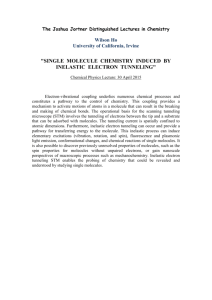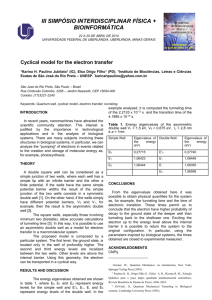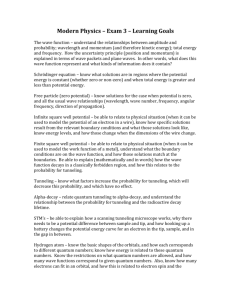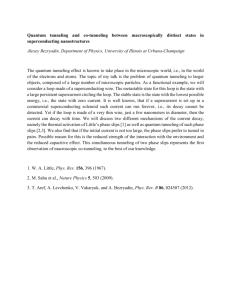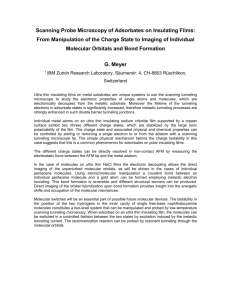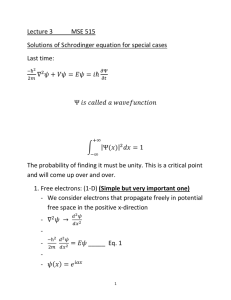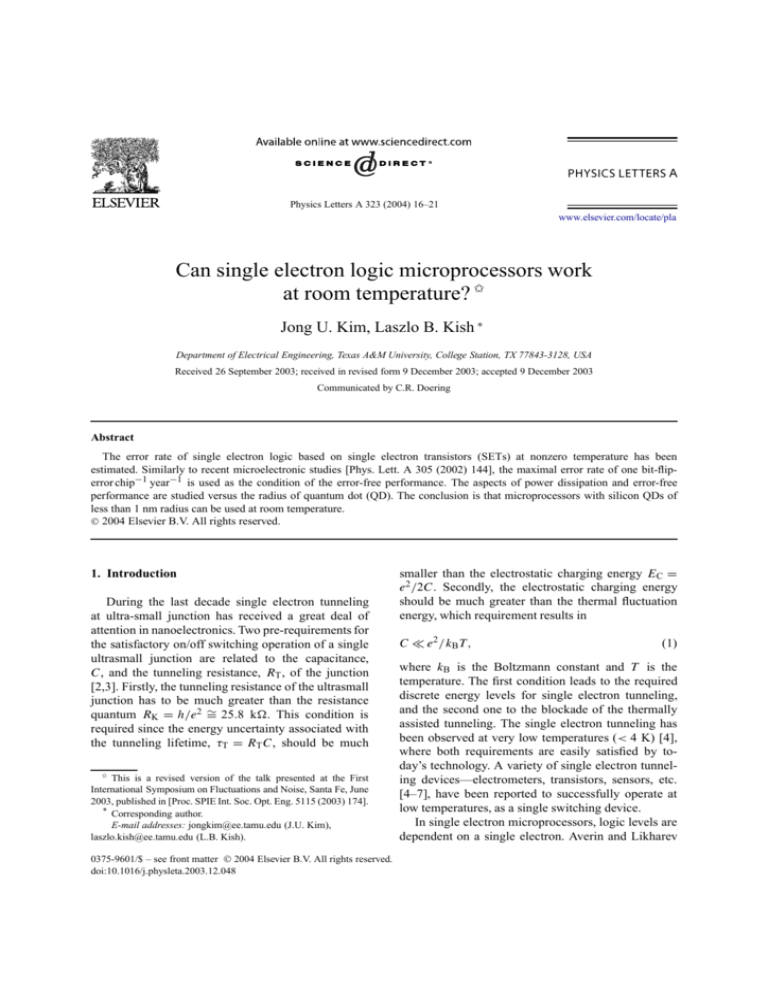
Physics Letters A 323 (2004) 16–21
www.elsevier.com/locate/pla
Can single electron logic microprocessors work
at room temperature? ✩
Jong U. Kim, Laszlo B. Kish ∗
Department of Electrical Engineering, Texas A&M University, College Station, TX 77843-3128, USA
Received 26 September 2003; received in revised form 9 December 2003; accepted 9 December 2003
Communicated by C.R. Doering
Abstract
The error rate of single electron logic based on single electron transistors (SETs) at nonzero temperature has been
estimated. Similarly to recent microelectronic studies [Phys. Lett. A 305 (2002) 144], the maximal error rate of one bit-fliperror chip−1 year−1 is used as the condition of the error-free performance. The aspects of power dissipation and error-free
performance are studied versus the radius of quantum dot (QD). The conclusion is that microprocessors with silicon QDs of
less than 1 nm radius can be used at room temperature.
2004 Elsevier B.V. All rights reserved.
1. Introduction
During the last decade single electron tunneling
at ultra-small junction has received a great deal of
attention in nanoelectronics. Two pre-requirements for
the satisfactory on/off switching operation of a single
ultrasmall junction are related to the capacitance,
C, and the tunneling resistance, RT , of the junction
[2,3]. Firstly, the tunneling resistance of the ultrasmall
junction has to be much greater than the resistance
quantum RK = h/e2 ∼
= 25.8 k. This condition is
required since the energy uncertainty associated with
the tunneling lifetime, τT = RT C, should be much
✩
This is a revised version of the talk presented at the First
International Symposium on Fluctuations and Noise, Santa Fe, June
2003, published in [Proc. SPIE Int. Soc. Opt. Eng. 5115 (2003) 174].
* Corresponding author.
E-mail addresses: jongkim@ee.tamu.edu (J.U. Kim),
laszlo.kish@ee.tamu.edu (L.B. Kish).
0375-9601/$ – see front matter 2004 Elsevier B.V. All rights reserved.
doi:10.1016/j.physleta.2003.12.048
smaller than the electrostatic charging energy EC =
e2 /2C. Secondly, the electrostatic charging energy
should be much greater than the thermal fluctuation
energy, which requirement results in
C e2 /kB T ,
(1)
where kB is the Boltzmann constant and T is the
temperature. The first condition leads to the required
discrete energy levels for single electron tunneling,
and the second one to the blockade of the thermally
assisted tunneling. The single electron tunneling has
been observed at very low temperatures (< 4 K) [4],
where both requirements are easily satisfied by today’s technology. A variety of single electron tunneling devices—electrometers, transistors, sensors, etc.
[4–7], have been reported to successfully operate at
low temperatures, as a single switching device.
In single electron microprocessors, logic levels are
dependent on a single electron. Averin and Likharev
J.U. Kim, L.B. Kish / Physics Letters A 323 (2004) 16–21
17
[8], and Korotkov [9] proposed single electron logic
gates and circuitry. They used the SET as the basic
component of these circuits. However, at non-zero
temperature, thermally assisted tunneling takes place
even at such bias/control voltages where the device
would have closed at zero temperature [8]. Apparently,
this phenomenon leads to bit flip errors.
In this article, the maximal error rate of one bitflip-error chip−1 year−1 or alternatively one bit-fliperror transistor−1 year−1 is used as the condition of the
error-free performance. In single electron logic chips,
this limit corresponds to one electron chip−1 year−1 .
Fig. 1. Single electron tunneling transistor with driving impedances.
The tunneling resistances and capacitances of the double junction
are R1 , C1 and R2 , C2 , respectively. CG is the gate capacitance.
The Zi s are the generator impedances of the driving (Z1 and ZG )
and the output (Z2 ).
2. Error-free performance condition
We consider a SET, with double single electron
junction, including a gate capacitor and a QD, with
low impedance driving and outputting, i.e., Z1 , Z2 ,
ZG RK , ω−1 C1−1 , ω−1 C2−1 , ω−1 CG−1 , as shown in
Fig. 1. Under these low-impedance conditions, the
single electron tunneling rate through each junction is
expressed as follows [10,11]:
→
−
Γ1=
=
←
−
Γ1
=
=
→
−
Γ2=
=
←
−
Γ2
=
=
E1r (V , VG , ne)
1
2
e R1 1 − exp[−βE1r (V , VG , ne)]
kB T
η1r
,
2
e R1 1 − exp(−η1r )
1
E1l (V , VG , ne)
2
e R1 exp[βE1l (V , VG , ne)] − 1
kB T
η1l
,
e2 R1 exp(η1l ) − 1
E2r (V , VG , ne)
1
e2 R2 1 − exp[−βE2r (V , VG , ne)]
kB T
η2r
,
2
e R2 1 − exp(−η2r )
E2l (V , VG , ne)
1
2
e R2 exp[βE2l (V , VG , ne)] − 1
kB T
η2l
,
2
exp(η
e R2
2l ) − 1
→
−
←
−
(2a)
(2b)
(2c)
R is the tunneling resistance, β = 1/kB T , and n is
the number of the excess charge on the QD. The
tunneling-related energies in Eq. (2) are defined by
E1r (V , VG , ne)
e
=
C2 +
C
E1l (V , VG , ne)
e
=
C2 +
C
E2r (V , VG , ne)
e
C1 +
=
C
E2l (V , VG , ne)
e
=
C1 +
C
CG
e
V + CG VG + ne − ,
2
2
(3a)
CG
e
V + CG VG + ne + ,
2
2
(3b)
CG
e
V − CG VG − ne − ,
2
2
(3c)
CG
e
V − CG VG − ne + ,
2
2
(3d)
and the dimensionless energies η’s are defined by
ηi (V , VG , ne) = βEi (V , VG , ne) =
(i = 1r, 1l, 2r and 2l).
(2d)
where Γ and Γ are the single electron tunneling rates
through the junction in a left-to-right and a rightto-left directions, respectively. The subscript number
represents the different junctions, and the subscripts r
and l represent the direction that an electron tunnels
from left to right and from right to left, respectively.
Ei (V , VG , ne)
kB T
(4)
Here, C is the sum of the capacitances, C =
C1 + C2 + CG . Eq. (2) shows that the tunneling rate
depends only on the dimensionless energy, ηi , and the
tunneling resistance at fixed temperature. At a given
tunneling resistance and temperature Eq. (4) allows us
to draw the different regimes of working, as shown in
Fig. 2 as a function of the source-drain voltage, V , and
0
=
the gate voltage, VG . The maximal error rate ΓSET
18
J.U. Kim, L.B. Kish / Physics Letters A 323 (2004) 16–21
Fig. 2. Working regimes of the SET with asymmetric junctions.
With symmetric junctions, the figures would be symmetric on the
axes. The dotted lines represent the boundaries between the “on”
and “off” states at zero temperature, while the solid lines represent
the conditions of the maximal error rate in the “off” state at room
temperature. Point O and P represent “off” and “on” states.
3.17 × 10−8 Hz, which corresponds to the limit of
one bit-flip-error transistor−1 year−1 , is used as the
condition of the error-free performance [12] on Fig. 2.
The dotted lines represent the boundaries between the
“on” and “off” states at zero temperature, while the
solid lines represent the conditions of the maximal
error rate in the “off” state. Each region represents
different tunneling combination. The checked regions
represent the zero current regions, defined by the
maximal error rate, and their area is temperature
dependent (see Eq. (4)). These regions exist if the
following conditions are satisfied simultaneously:
ηj r (V , VG , ne) −αjr (Rj , T ),
ηj l (V , VG , ne) αjl (Rj , T ),
(5)
where we call the α’s stability parameters. Eqs. (3), (4)
and relations (5) are used to generate Fig. 2.
It is important to note here that in order to have
a reasonable estimation of the α’s used in Eq. (5),
we have proceeded in the following way. The actual
values of the α’s can be obtained from the following
Fig. 3. Stability parameter as a function of temperature. It is
evaluated by using Eq. (6).
equations:
0
−αjr (Rj , T )
e2 Rj
ΓSET
=
,
kB T
1 − exp[αjr (Rj , T )]
(6a)
or using the backward tunneling rate:
0
αjl (Rj , T )
ΓSET
e2 Rj
=
kB T
exp[αjl (Rj , T )] − 1
(j = 1, 2), (6b)
where Eqs. (6a) and (6b) are relevant to the different
tunneling direction and they give the same result
for the α’s. Fig. 3 shows the dependence of the
stability parameter on temperature at the different
tunneling resistance. It shows that although the α’s
are implicit functions of the tunneling resistance
and temperature, they can be approximated by the
following semiempirical way:
−
→Y 2
Γ e Rj
∼
α(Rj , T ) = ln α(Rj , T ) − ln
kB T
R
j
∼
,
(7)
= ᾱ − n ln
106 T
where ᾱ = 41.1 and n = 1.025 for a single SET.1 After
substituting the α obtained from Eq. (7) into Eq. (5),
1 The stability parameter also depends on the number N of
the SETs in a chip since the error rate is proportional to N .
J.U. Kim, L.B. Kish / Physics Letters A 323 (2004) 16–21
the error-free zero current condition is obtained from
Eqs. (3), (4), (5) and (7):
e2
(8)
> α(RT , T )kB T .
2C
Eq. (8) expresses the condition of having the tunneling
rate below the maximal error rate in the “off” state.
At practical operation the V and VG has to satisfy two different kinds of requirements [1]. First, the
drain voltage cannot be greater than V max which corresponds to the maximal error rate in the “off” state.
Second, in the “on” state, the gate should be driven by
opt
VG which provides the maximal possible current at
given V max . In Ref. [1], simple considerations based
on Eqs. (3) lead to
e α1r C kB T
2
max
,
−
= min
V
2C1 + CG 2
e
2
e α1r C kB T
−
(9a)
2C2 + CG 2
e
and
opt
VG =
e
2CG
+ (2C1 + CG )α1 − (2C2 + CG )α2 kB T
× [2eCG ]−1 ,
(9b)
where αj = α(Rj , T ) and min(a, b) represents the
minimum of a and b. If the two junctions are symmetric, i.e., C1 = C2 , R1 = R2 = R, then Eqs. (9) will
be simplified so that the operation voltages in the “on”
opt
state become V max = e/2C and VG = e/2CG . In
this case, we have the maximal rate of electron flow
through the device:
→
−
Γt =
1
1
∼
.
=
2
8C R[1 − exp(−βe /4C )] 8C R
(10)
Eq. (10) is based on unidirectional tunneling because tunneling in the reverse direction would be negligible at the maximal tunneling rate conditions.
When the transistor runs at the maximal clock
frequency, the dissipation power of a single SET with
symmetric junctions is
→
−
opt
P1 = e · Γ t · VG =
e2
.
16CG C R
(11)
The maximal error rate for the chip with N SETs is one bit-flip0 = Γ 0 /N . For a chip with 109
error chip−1 year−1 , i.e., Γchip
SET
SETs, we get α 9 ∼
= 1.025 ln(106 /RT T ) − 62.25.
10
19
It is important to note that this is the ultimate lower
limit of dissipation because Eq. (11) takes into the
account only the energy needed to control the device.
The actual power dissipation of the device is not
included in this picture because it can be dependent
on several other conditions.
3. Size-dependence
In general, the semiconductor SET is built in lateral
structure which has 2-dimensional electron gas. In the
lateral structure, the QD of the SET is supposed to be a
flat circular disk. Therefore, using the size dependence
of the geometric capacitance, C = 8εRQD [13], we
obtain the following relations for the size dependence
of the error-free performance condition:
RQD P1 =
e2
,
16εα(R, T )kB T
→∼
−
Γ =
e2
,
128εCG RQD R
1
,
64εRQD R
(12)
where ε is the permittivity of insulator and RQD is the
radius of a flat circular disk. Eq. (12) holds for SET
with symmetric junctions.
Today, the number of MOS transistors in the
Pentium 4 microprocessor is about 100 millions/cm2
and the characteristic size of lithography is around
100 nm. Comparing this transistor density with the
case of densely packed transistors, we can see that the
transistor packing density θ = 0.01, where θ is the
ratio of the actual number transistors to the number
of devices of the characteristic size at fully dense
packing. From Eq. (12), the power dissipation of a chip
with N SETs can be given as
PN = NP1 = N
≈θ
e2
128εCG RQD R
10−4
10−4 e2 θ
e2
=
. (13)
2 128εC R
3 R
RQD
128εCG RQD
G QD R
It should be noted that this is the lower limit of power
dissipation of the chip because the dissipation of other
elements are neglected.
Fig. 4 shows the lower limit of power dissipation
(when running at the maximal clock frequency); the
maximal clock frequency of the single SET; and the
20
J.U. Kim, L.B. Kish / Physics Letters A 323 (2004) 16–21
Fig. 4. Lower limit of power dissipation in single electron logic.
Power dissipation of a single SET and a chip with N SETs; and the
maximal clock frequency; as a function of the radius of the quantum
dot. The same packing density θ = 0.01 is supposed as in today’s
microprocessor chips.
power dissipation of 109 SETs. Here, ε = 3.9ε0 for
SiO2 , R = 1 M and CG /C = 0.1 are assumed.
It is apparent from Eqs. (12) and (13) and from the
−1
, P1 ∝
slope of curves in Fig. 4 that fMAX ∝ RQD
−2
−4
RQD
, and PN ∝ RQD
. It is important to point out that
the power dissipation limits of chips, which is today
(2003) about 100 W, sets another upper limit for the
clock frequency. When the maximal power dissipation
of the chip is limited at 100 W, the radius of the QD
and the maximal clock frequency are about 6 nm and
30 GHz, respectively. It implies that microprocessors
with RQD 6 nm cannot operate at the maximal clock
frequency fMAX . In fact, the maximal clock frequency
is less than Eq. (11) due to shot noise [8].
Finally, we study the maximal quantum dot size
versus temperature. The results are compared by a
simple prediction based on the level-crossing analysis of thermal noise at given capacitance and bandwidth
[12]. The rms thermal noise voltage Vn =
√
kB T /CG on the capacitor and the practical noise
opt
margin VG 12Vn used in [11] yields the following
relation:
CG 1 e2
.
576 kB T
(14)
Fig. 5. Maximum radius of the quantum dot for operation at
given temperature. The thin solid line represents the requirement
of efficient DC switching (on/off) of the device. The other lines give
the maximal size for the error-free performance. The dashed line
is for a single SET. The rest of the lines are for a chip with 109
SETs. The thick solid line is given by Eq. (12), the dashed-dotted
line is given by the thermal noise level-crossing analysis [12], and
the dotted line estimates the case where the size-quantization effect
dominates; it is extrapolated below 2.8 nm.
In Fig. 5, the thin solid line represents the case
where the charging energy is equal to thermal energy,
i.e., the device can be used only as a DC switch which
is not suitable for error-free data manipulation. Surprisingly, the simple thermal noise estimation works
very well at large QD limit. However, as the size of
the QD decreases, the size quantization effect becomes
dominant.2 That case has a different slope3 because
−1/2
T ∝ RQD . So, the size quantization effect is a beneficial effect which helps to work at higher temperatures
2 The radius of the QD is, respectively, 2.77 nm for Si/SiO ,
2
at which the ratio of energy level spacing in quantum dot to
electrostatic charging energy, EQD /EC = 4π h̄2 C /me e2 AQD is
unit. Here me is the effective mass of the electron and AQD is the
area of the quantum dot.
3 The energy level spacing from the size-quantization effect is
proportional to 1/RL2 , where RL is the characteristic length of the
QD. Since the thermal energy is much less than the spacing between
energy levels, the maximum characteristic length of the QD satisfies
log(RL )MAX ∝ (−1/2) log T .
J.U. Kim, L.B. Kish / Physics Letters A 323 (2004) 16–21
or bigger sizes. The analysis of Fig. 5 suggests that a
microprocessor including 109 SETs with smaller than
1 nm QD size can work at room temperature.
4. Summary
The aspects of power dissipation and error-free performance have been studied versus the radius of quantum dot (QD). The analysis shows that microprocessors with silicon QDs of less than 1 nm radius can be
used at room temperature in single electron logic microprocessors. The most important conclusion is that a
single electron microprocessor working at room temperature has to be in the size quantization working
mode.
It is important to note that we have used various approximations in order to estimate the ultimate higher
limit of quantum dot size at the required error rate.
Some of the implicit assumptions are as follows:
(i) For the most optimistic estimation, we supposed
that higher-order co-tunneling [14] is negligible,
even though it can be important in the Coulombblockade region, depending on the geometry and
the materials used.
(ii) We have not investigated the impact of possible
error correcting methods on the results. However,
it is important to mention that, at a given number of devices, the Shannon information channel
capacity (the bit/second information measure) of
the system cannot increase by using error correction. The error rate can be improved but the Shannon information channel capacity will decrease at
any kind of error correction.
21
Acknowledgements
The research has been sponsored by the Army Research Office (ARL/ARO), Office of Naval Research
and TAMU Telecommunication Task Force. Comments of and discussions with Alexander Korotkov
and Mark Dykman are appreciated.
References
[1] J. Kim, L.B. Kish, Proc. SPIE Int. Soc. Opt. Eng. 5115 (2003)
174.
[2] M.H. Devoret, H. Grabert, in: H. Grabert, M.H. Devoret (Eds.),
Single Charge Tunneling, in: NATO ASI Series B, vol. 294,
Plenum, New York, 1992, pp. 1–19.
[3] D.V. Averin, K.K. Likharev, in: B.L. Altshuler, P.A. Lee,
R.A. Webb (Eds.), Mesoscopic Phenomena in Solids, Elsevier,
Amsterdam, 1991, pp. 176–216.
[4] D.H. Kim, S.-K. Sung, J.S. Sim, K.R. Kim, J.D. Lee, B.-G.
Park, B.H. Choi, S.W. Hwang, D. Ahn, Appl. Phys. Lett. 79
(2001) 3812.
[5] R.J. Schoelkopf, P. Wahlgren, A.A. Kozhevnikov, P. Delsing,
D.E. Prober, Science 280 (1998) 1238.
[6] L. Zhuang, L. Guo, S.Y. Chou, Appl. Phys. Lett. 72 (1998)
1205.
[7] R. Knobel, A.N. Cleland, Appl. Phys. Lett. 81 (2002) 2238.
[8] D.V. Averin, K.K. Likharev, in: H. Grabert, M.H. Devoret
(Eds.), Single Charge Tunneling, in: NATO ASI Series B,
vol. 294, Plenum, New York, 1992, p. 313.
[9] A.N. Korotkov, Int. J. Electronics 86 (1999) 511.
[10] G.-L. Ingold, Y.V. Nazarov, in: H. Grabert, M.H. Devoret
(Eds.), Single Charge Tunneling, in: NATO ASI Series B,
vol. 294, Plenum, New York, 1992, pp. 21–107.
[11] G.-L. Ingold, P. Wyrowski, H. Grabert, Z. Phys. B 85 (1991)
443.
[12] L.B. Kish, Phys. Lett. A 305 (2002) 144.
[13] D.K. Ferry, S.M. Goodnick, Transport in Nanostructures,
Cambridge Univ. Press, New York, 1999.
[14] S. De Franceschi, S. Sasaki, J.M. Elzerman, W.G. van der Wiel,
S. Tarucha, L.P. Kouwenhoven, Phys. Rev. Lett. 86 (2001) 878.

